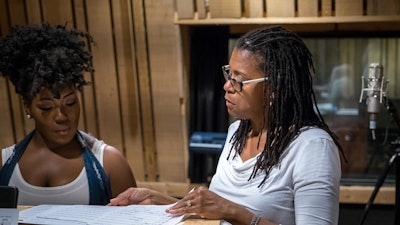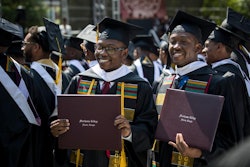 Lenora Hammonds, associate professor of jazz studies at North Carolina Central University, received support recently from the National Endowment for the Arts. Hammonds shared advice on her application process at the national HBCU conference this week.
Lenora Hammonds, associate professor of jazz studies at North Carolina Central University, received support recently from the National Endowment for the Arts. Hammonds shared advice on her application process at the national HBCU conference this week.
To help address funding needs, a session with panelists who recently received National Endowment for the Arts (NEA) or National Endowment for the Humanities (NEH) grants offered advice to prospective applicants.
“It’s important to not be quiet about something you’re doing on campus that you’re excited about,” said Lenora Helm Hammonds, an associate professor of jazz studies at North Carolina Central University (NCCU). Hammonds recently received NEA support for a teaching artist certification program at NCCU. “I just started reaching out to people, saying this is what I have, who do you know that can help me figure out what I don’t know.”
Tina Rollins, director of Hampton University’s William R. and Norma B. Harvey library, agreed and suggested building relationships with the institution’s grant coordination office as well as with NEA or NEH staff.
“Know your connections on campus that will help walk you through what you need for your application,” said Rollins, who received NEH support to develop a national forum on the recruitment and retention of minority library professionals. “It’s always great to have a cheerleader in the office of sponsored programs or grants who will take your calls.”
Rollins and Hammonds both shared the impact of their grants on garnering more respect for their work in the humanities.
“It created a way for activists who were artists in my community to be able to say, ‘Oh, NEA thinks that this is viable and important and interesting to support. Therefore, my work is viable and important and interesting to support,’” said Hammonds.
In the session on STEM students at HBCUs, researchers shared their findings from analyzing student data across higher education institutions. The scholars found that HBCUs have a unique track record of educating Black students in STEM.
“In general, we see that Black students would have been more likely to graduate from college if they attended an HBCU,” said Dr. Omari Swinton, professor of economics and chair of the department of economics at Howard University. “And if they graduated from an HBCU, they would have been more likely to have graduated into the STEM field.”
Dr. James Koch, Board of Visitors professor of economics and president emeritus at Old Dominion University, stressed another finding when looking at the parental income of students at HBCUs compared to those at Predominantly White Institutions (PWI).
“HBCUs are providing their students with much more upward economic mobility than PWIs,” said Koch.
His team compared the earnings of graduates to those of their parents to understand the long-term impact of higher education institutions on low-income students especially.
“You are well likely to be ahead of your parents’ earnings and have a greater chance that you're going to move up to the top 20% of income if you came from the bottom 20% of income when you graduate from an HBCU,” said Dr. William Spriggs, professor of economics at Howard University and chief economist to the American Federation of Labor and Congress of Industrial Organizations (AFL-CIO).
These kinds of metrics are often missing when colleges are ranked nationally, Spriggs added.
“Not having on that scorecard this context of student mobility and what the college is actually achieving can be misleading,” he said. “We’re looking at the long-term horizon of the student, not the short-term horizon of the scorecard.”
Yet states use similar scorecards for funding decisions to higher education institutions, which Spriggs argues puts HBCUs at a disadvantage, obscuring their importance in particular as a STEM graduate pipeline.
Spriggs added that the racial wealth gap exists among institutions in higher education, not only for individuals. PWIs generally have more resources than HBCUs, and yet HBCUs by-and-large graduate greater numbers of low-income students and students of color.
“We’re talking about HBCUs with different histories, different resources, different locations,” said Spriggs. “The one thing in common is a commitment to access, as evidenced by a very large share of low-income students at HBCUs. The common denominator is an intention to graduate our students.”
On why HBCUs graduate so many underrepresented students, Spriggs said that intangible quality is behind the numbers.
“I can give you the ingredients of the best chefs in America. That doesn’t mean you can cook like they do. You have to have the intention,” said Spriggs. “Are you driven by purpose? Are you really trying to achieve something? And the data points to how that in and of itself is vitally important.”
Rebecca Kelliher can be reached at [email protected]



















